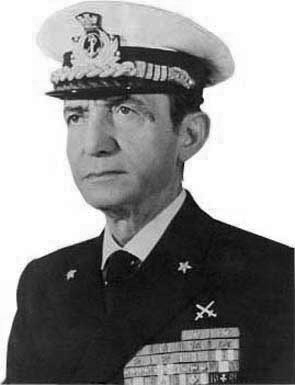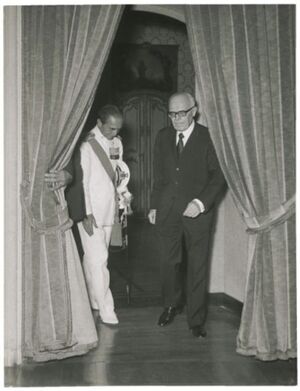Eugenio Henke
(spook) | ||||||||||
|---|---|---|---|---|---|---|---|---|---|---|
 | ||||||||||
| Born | 15 November 1909 Genoa, Italy | |||||||||
| Died | 4 February 1990 (Age 80) Rome, Italy | |||||||||
Cause of death | heart attack | |||||||||
| Nationality | Italian | |||||||||
| Alma mater | Royal Naval Academy of Livorno | |||||||||
Italian admiral who held the positions of director of the Defense Information Service (SID), where he was involved in several dramatic incidents.
| ||||||||||
Eugenio Henke was an Italian admiral who held the positions of director of the Defense Information Service (SID), where he was involved in several dramatic incidents, and subsequently of Chief of Defense staff.
Early Life
He was born in Genoa on November 15, 1909 , the son of Edoardo and Amalia Giordano. He began his career in the Italian Royal Navy by enrolling in the ordinary courses of the Royal Naval Academy of Livorno, becoming ensign on 1 July 1931 .

At the outbreak of the Second World War, with the rank of lieutenant, he was second in command of the destroyer Vincenzo Gioberti, and remained on board until October 1941. This period earned him two Bronze Medals for Military Valor for having participated in over 40 war missions and 16 convoys escort missions. Among the 40 missions in which he participated, the battle of Punta Stilo, that of Capo Teulada and that of Capo Matapan.
He served as commander of the escort torpedo boat Orsa, on which he was promoted to lieutenant captain on March 10, 1942. At the armistice of 8 September 1943 he was in La Spezia under the command of VAS 235. Towards mid-morning on 9 September the growing presence of German troops in La Spezia (sent in to occupy Italy by surprise) induced him to leave the port with the VAS 234, commanded by Rear Admiral Federico Martinengo. When the two Italian units reached the height of the island of Gorgona they were intercepted by two German minesweepers, sailed from Livorno to intercept the Italian units.
After the latter refused to stop, the German units opened fire, and in the furious combat that followed, VAS 234 was hit, on which Rear Admiral Martinengo fell while at the helm. The two VAS-boats were repaired at Cala Scirocco, while the German minesweepers also returned to Livorno with serious damage and numerous deaths and injuries on board. The VAS 234 exploded after its crew had managed to get away, while the VAS 235, temporarily repaired, reached Porto Torres on 23 September.
Subsequently he became commander of the submarine fighter Sant'Alfonso, and on 1 November 1943 he was assigned to the superior torpedo command as head of the training service.
After the war he remained in office as head of the training service until 1947, the year in which he became deputy chief of staff of the Navy and the following year, on 1 January, he was appointed frigate captain.
After a few years of ordinary activity, on 11 December 1951 he was appointed commander of the 1st Corvette Squadron of the school of the naval command of Rome and then from 1953 to the direct service of the Ministry of Defense. In 1954 he was promoted to the rank of vessel captain, reaching the rank of deputy chief. In his career he later became head of the office of the general secretariat of the Navy and at the same time held the position of commander of the navy of Rome and, by virtue of his commendable work, on December 31, was appointed rear admiral in 1960. On December 31, 1964 he was appointed division admiral holding the command of the 4th Italian naval division.
Intelligence work
He was the first director (after the reform of the intelligence services of 1965 which suppressed the SIFAR then directed by General Giovanni Allavena) of the SID (Defense Information Service) between July 1966 and October 1970, the years in which the strategy of tension in Italy began. He was promoted to full admiral on January 1, 1968.
During this time the massacre of Piazza Fontana (1969) happened, which involved elements of allegedly 'rouge' secret services. Guido Giannettini, a Z-agent involved in the investigation into the massacre, was enlisted in one of the anti-espionage cells, and had contact both with Franco Freda and Giovanni Ventura.[1]
Henke always denied having conducted investigations into the Piazza Fontana massacre, but the Ministry of the Interior in 1970 said that it was the SID that had reported a certain Guerin Serac, a character who turned out to be non-existent, as the instigator of the attack. In October 1970 he left the post of SID, replaced by General Vito Miceli.[2]
Subsequently Henke was Commander of the Central Mediterranean for NATO and Vice President of the Marine Section of the Superior Council of the Armed Forces. From 1970 to July 1972 he held the position of Commander-in-Chief of the Naval Squad.
On 1 August 1972 he was appointed by the Council of Ministers as the new Chief of Staff of Defense, replacing General Enzo Marchesi, a position he held until 31 January 1975. It was the first time that an admiral held this position in Italy. Until then it was held only by officers of the Army. He was called by the judiciary to testify on various investigations, such as the Borghese coup, on the 1974 oil scandal, in which the commander of the Guardia di Finanza, Raffaele Giudice was involved, and on the investigation relating to the murder of the journalist Mino Pecorelli[1]. In April 1989, he was tried for helping to hide on the truth on the intelligence plane that crashed in Marghera in the autumn of 1973, in what was not an accident but an act of sabotage carried out by the Israeli Mossad in retaliation for the release of some Arab terrorists.
He died in Rome, at the Celio military hospital, on February 4, 1990.
References
- ↑ a b https://www.difesa.it/SMD_/CaSMD/CapiSMD/Pagine/Ammiraglio_Eugenio_HENKE.aspx
- ↑ Mario Guarino e Fedora Raugei, Licio Gelli: Vita, misteri, scandali del capo della Loggia P2, Bari, Edizioni Dedalo, 2016. page 97